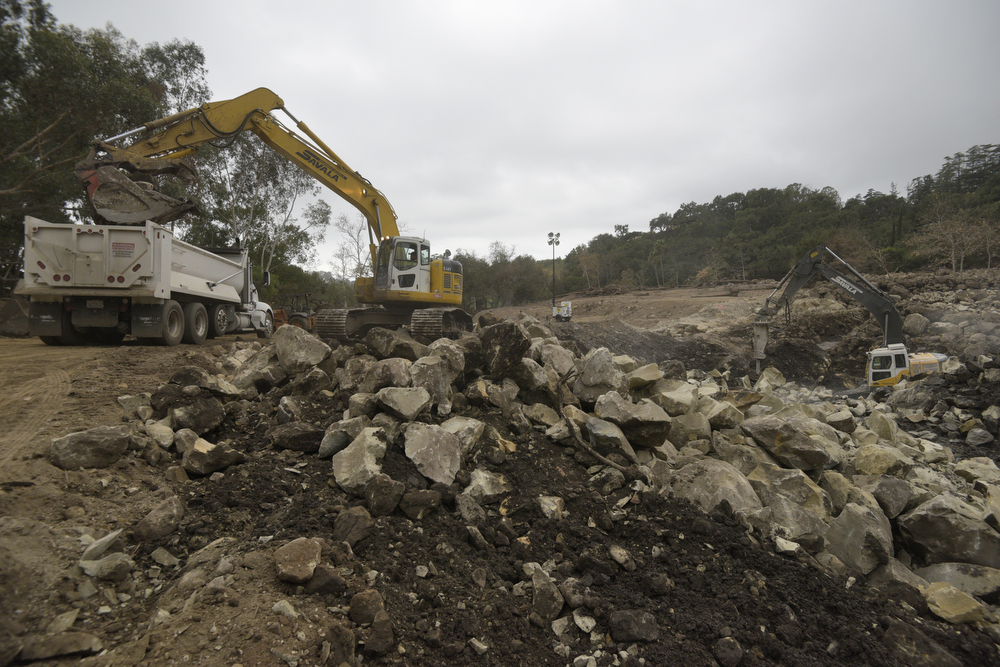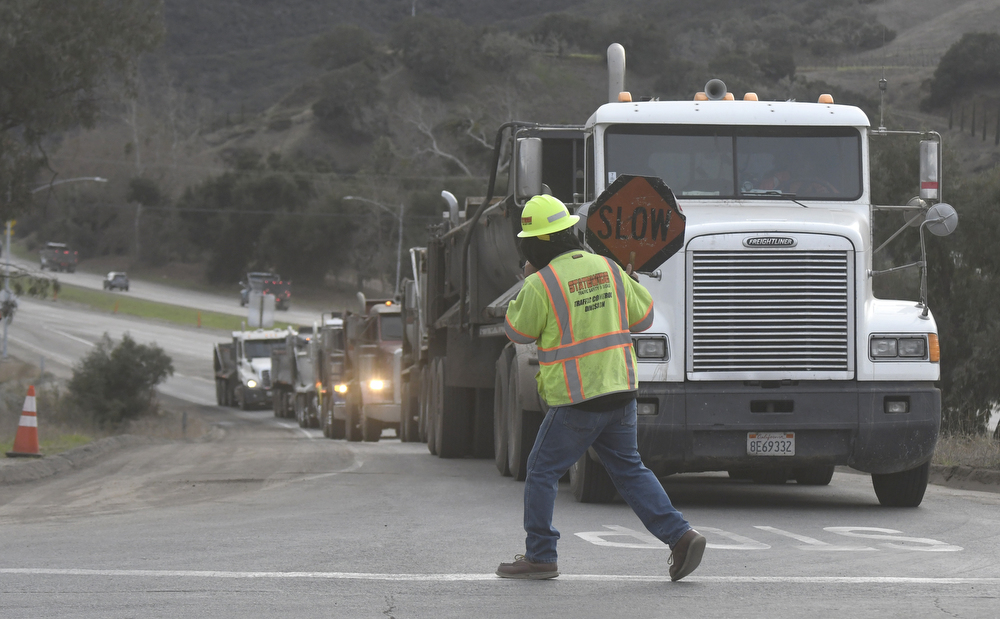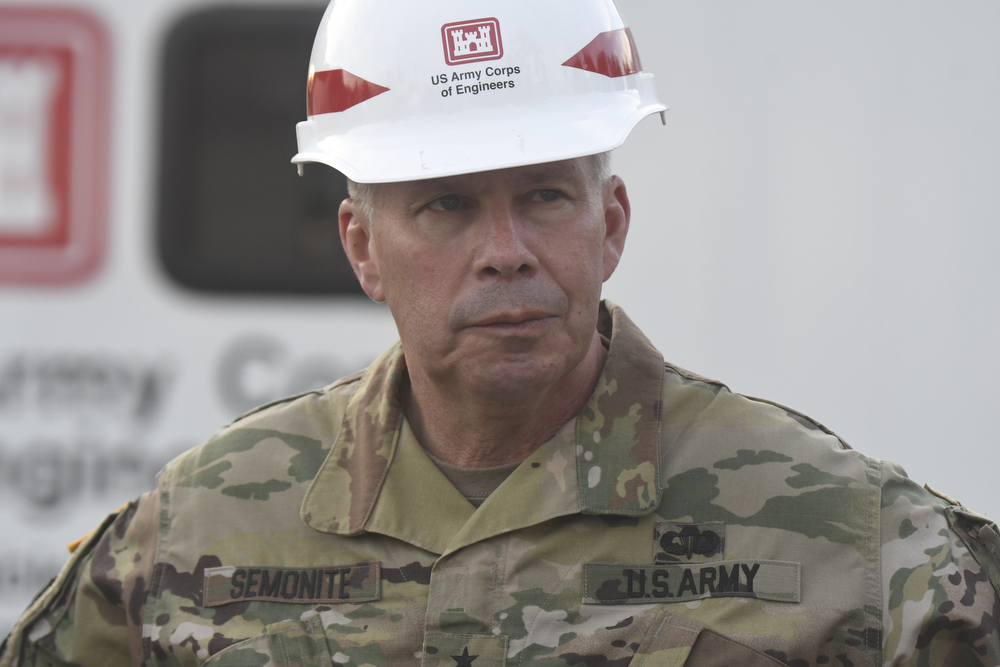How Montecito Mud Winds Up at Goleta Beach
Environmental Planners Call it ‘Beach Nourishment’

A whiff of charred wood comes off the piles of black mud that are dumped daily into the ocean at Goleta Beach County Park, part of the cleanup of Montecito in the wake of the catastrophic January 9 debris flow. It’s mud from the Thomas Fire burn area in the mountains behind the community, and, according to Seth Shank, a senior environmental planner with County Flood Control, it will look like beach sand within 24 hours.
“Beach nourishment, that’s what we call it,” he said, noting that there is now a strip of sand at high tide where there had been none in recent years. “You can smell the fire, but it’s really beach-compatible — coarse-grained and sandy without a lot of clay.”
The beach may be coming back, but the water’s unhealthy. Swimming and surfing are off-limits at Goleta Beach, Arroyo Burro Beach, Carpinteria State Beach, El Capitan State Beach, Hope Ranch Beach, Leadbetter Beach, Summerland Beach, and Hammond’s Beach because of high levels of bacteria in the water, County Public Health officials said on Wednesday. The county is conducting weekly ocean water sampling along the coast.
Since January 11, Shank said, County Public Works crews have dumped between 10,000 and 13,000 cubic yards of mud at Goleta Beach, averaging about 100 truckloads per day. That’s less than the 15,000 cubic yards that were dumped on the beach after a routine cleanup in the Goleta Slough last fall, he said. During the very wet winter of 1995, by comparison, 500,000 cubic yards of mud from the slough were deposited onto Goleta Beach, Shank said.
East of Montecito, the sand and silt that poured into the Carpinteria Salt Marsh Reserve from Franklin and Santa Monica creeks on January 9 is being dredged out and dumped into the ocean at Ash Avenue — more than 14,000 cubic yards to date. “Out of an abundance of caution,” a Public Health press release said, the public is barred from walking within 400 feet of the dumping zone there and at Goleta Beach.
This week, Shank said, the county began taking random samples of mud from dump trucks at Goleta Beach and Ash Avenue. The samples are sent to a lab in Santa Maria to be tested for toxins, including heavy metals, gasoline, and polychlorinated biphenyls, or hazardous chemicals that were formerly used in electrical transformers. Testing will be performed at both locations at least once a week as the cleanup continues, Shank said.
Tests of mud samples taken in Montecito on January 13-14 by a consulting firm for the county have detected levels of two substances — fecal bacteria from untreated sewage and chemicals found in gasoline and motor oil — that could pose a health risk to cleanup workers. Workers have been advised to wear rubber boots and nitrile gloves and wash their hands often.

All dump trucks carrying mud and debris from Montecito must travel first to the Ventura County Fairgrounds, where their loads are sorted into piles of mud, rocks, metal, and woody debris.
At Goleta Beach, Shank said, truckloads of mud containing too much trash are turned away. After a load is dumped, bulldozers spread it out on a portion of beach near the upper parking lots. County workers pick out pieces of scorched trees and other debris and throw them into a dumpster. Occasionally, they have found personal effects, Shank said — photographs, notebooks, even a china plate — which are saved in hopes of locating the owners.
As the cleanup proceeds, county officials said, Montecito roads and culverts are expected to be largely cleared by January 31. Some repairs will take longer, including restoration of the arched bridge at Ashley Road and Highway 192, where the mudflow left a mark 12 feet high on the surrounding trees. (Dramatic drone videos show the bridge before-and-after view at the county’s Facebook page.)

The creeks below the Thomas Fire burn area have been cleared so that water can flow down them, said Tom Fayram, deputy director of County Public Works. But the masses of rock and mud that were scooped out and dumped along the banks must still be removed, and that’s potentially a job for the U.S. Army Corps of Engineers, he said.
It will take at least another month, according to Fayram, for the Army Corps to finish cleaning out the 11 debris basins that act as safety checks on the creeks. In the San Ysidro Creek basin, he said, the rocks and debris were piled up 30-40 feet above the rim. Overall, only 40,000 cubic yards of mud, rocks, and dead trees, or 10 percent of the 400,000 cubic yards that dropped into the basins on January 9, have been removed, Fayram said: “It’s indescribable what happened out there.”



